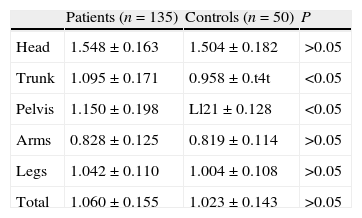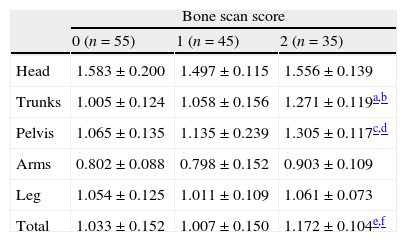To evaluate total body bone mineral density and regional bone mineral density in patients with prostate cancer with and without metastases, and to correlate them with bone scintigraphy findings.
Patients and methods135 patients with prostatic carcinoma and 50 healthy subjects were investigated with bone scintigraphy and dual-energy X-ray absorptiometry. The bone scintigraphic findings were classified as normal (score 0: n=55), abnormal but not typical for metastases (score 1: n=45), and typical pattern of metastases (score 2: n=35).
ResultsThe patients with bone metastases prostate cancer had significantly higher total bone mineral density and regional bone mineral density of trunk and pelvis than healthy controls and prostate cancer patients without bone metastases. There was a significant positive correlation between bone scan score and total bone mineral density and regional bone mineral density of trunk and pelvis (r=0.328; P<0.05; r=0.60; P<0.001; r=0.480; P<0.001, respectively).
ConclusionBone metastasis is a major cause of morbidity in prostatic cancer; bone loss during hormonal treatment is currently effective. Our results show that patients of prostate cancer with bone metastases have increased bone mineral density (BMD) in the pelvis and trunk, possibly because of a predominance of osteoblastic over osteolytic metastases demonstrated by 99mTc MDP bone scan.
Evaluar la densidad mineral ósea total y la densidad mineral ósea regional en pacientes de cáncer de próstata con y sin metástasis, estableciendo una relación con los resultados de la escintigrafía ósea.
Pacientes y métodosLa investigación se realizó sobre un grupo de 135 pacientes con carcinoma prostático y 50 pacientes sanos empleando escintigrafía ósea y absorciometría de rayos X de doble energía. Los resultados de la escintigrafía ósea se clasificaron como normales (puntuación 0: n=55), anómalos pero no típicos de metástasis (puntuación 1: n=45) y patrón típico de metástasis (puntuación 2: n=35).
ResultadosLos pacientes de cáncer de próstata con metástasis ósea presentaban una densidad mineral ósea total y regional muy superior en el tronco y la pelvis que los sujetos control sanos, y que los pacientes de cáncer de próstata sin metástasis óseas. Se encontró una relación positiva significativa entre la puntuación obtenida en la exploración ósea y la densidad mineral ósea total y regional de tronco y pelvis (r=0,328, p<0,05, r=0,60, p<0,001, r=0,480, p<0,001, respectivamente).
ConclusiónLa metástasis ósea es una de las causas principales de morbilidad en el cáncer de próstata, y la pérdida ósea en el transcurso del tratamiento hormonal tiene eficacia en la actualidad. Nuestros resultados muestran que los pacientes de cáncer de próstata con metástasis ósea presentan una mayor densidad mineral ósea (DMO) en la pelvis y el tronco, lo cual es probable que se deba al predominio de las metástasis osteoblásticas sobre las osteolíticas, como demuestra la exploración ósea 99mTc MDP.









